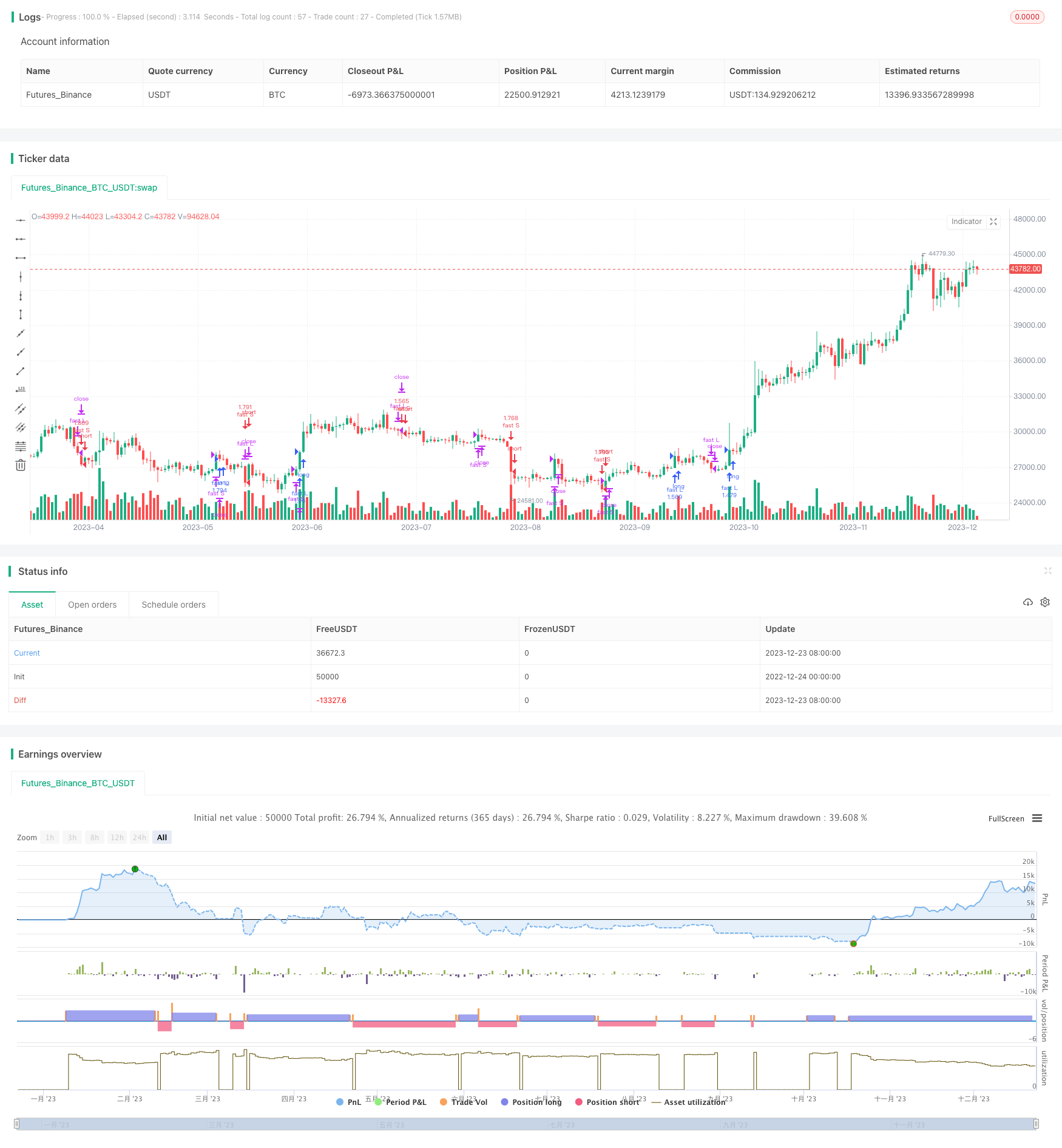Name
一种追踪突破动量的海龟交易策略Turtle-Trading-Strategy
Author
ChaoZhang
Strategy Description
海龟交易策略(Turtle Trading Strategy)是一种追踪突破动量的趋势跟踪策略。它由著名交易员理查德·丹尼斯(Richard Dennis)在20世纪80年代开发,用来验证交易员是否可以通过规则来培养,而不是天生的。该策略的核心理念是追踪价格突破并跟踪趋势,同时严格遵守资金管理原则以限制下行风险。
海龟交易策略使用两个参数N和N/2构建通道。具体来说,分别计算最近N天和N/2天内的最高价、最低价。当价格超过N天通道时建立多头仓位,当价格跌破N/2天通道时平仓;当价格跌破N天通道时建立空头仓位,当价格超过N/2天通道时平仓。这样做的目的是追踪价格趋势同时控制风险。
代码中,N对应enter_slow,N/2对应enter_fast。分别计算最近55天和20天的最高价ighest(slowL和fastL)、最低价lowest(slowS和fastS)。当价格超过55天通道时做多(enterL2),当价格跌破20天通道时平多仓(exitL1);当价格跌破55天通道时做空(enterS2),当价格超过20天通道时平空仓(exitS1`)。
海龟交易策略最大的优势在于风险控制。通过在价格突破时建立仓位,在价格回撤时快速止损,可以有效控制单笔损失。同时采用固定份额资金管理原则,进一步降低了风险。
另一个优势是参数选择简单。整个策略只有4个参数,容易理解和调整。参数本身也比较稳定,不需要频繁优化。
海龟交易策略最大的风险在于无法跟踪长期趋势。当趋势开始形成时,该策略可能错过入场机会。另外,价格震荡趋势中,该策略会频繁开仓平仓,增加交易成本和滑点风险。
此外,固定的参数设置也可能在不同品种和市场环境下效果差异很大。这需要人工经验进行调整。
海龟交易策略可以从以下几个方面进行优化:
-
增加参数自适应功能。允许N、N/2的参数根据市场波动性和信号频繁度自动调整,适应更多场景。
-
增加趋势判断规则。在入场之前判断趋势方向,避免价格震荡行情的错误入场。
-
结合多个时间周期unity策略。在更高时间周期确定趋势方向,在更低时间周期入场。
-
优化止损策略。trailing 止损或时间止损,降低回撤。
海龟交易策略通过简单的突破系统实现了有效的趋势跟踪。风险控制是该策略最大的优势,这得益于快速止损和固定资金管理。与此同时,我们也看到该策略可以从多个维度进行扩展与优化,适应更多品种和市场环境。总的来说,海龟交易策略提供了一个风险可控的方法来捕捉价格趋势,是量化交易的一个重要参考。
||
The Turtle Trading Strategy is a trend following strategy that tracks momentum breakouts. It was developed by famous trader Richard Dennis in the 1980s to prove that traders could be nurtured by rules rather than born. The core idea of the strategy is to track price breakouts and follow trends, while strictly adhering to money management principles to limit downside risk.
The Turtle Trading Strategy uses two parameters N and N/2 to construct channels. Specifically, it calculates the highest and lowest prices over the most recent N days and N/2 days. When the price exceeds the N-day channel, a long position is established. When the price falls below the N/2-day channel, the position is closed. Similarly, when the price breaks the N-day channel to the downside, a short position is established, and closed when the price rises above the N/2-day channel. The goal is to follow price trends while controlling risk.
In the code, N corresponds to enter_slow and N/2 corresponds to enter_fast. The highest prices (slowL and fastL) and lowest prices (slowS and fastS) over the most recent 55 days and 20 days are calculated separately. Long positions are opened when the price exceeds the 55-day channel (enterL2) and closed when the price falls below the 20-day channel (exitL1). Short positions are opened when the price breaks the 55-day channel downwards (enterS2) and closed when the price rises above the 20-day channel (exitS1).
The biggest advantage of the Turtle Trading Strategy is risk control. By establishing positions on price breakouts and stopping out quickly on pullbacks, it effectively controls losses on individual trades. The use of fixed fractional position sizing further reduces risk.
Another advantage is simple parameter selection. The entire strategy has just 4 parameters that are easy to understand and tune. The parameters themselves are also quite stable, without needing frequent optimization.
The biggest risk of the Turtle Trading Strategy is the inability to track long-term trends. It may miss entry opportunities when trends start to form. Also, in choppy price oscillation environments, the strategy will trigger frequent entries and exits, increasing transaction costs and slippage risks.
In addition, the fixed parameter settings could perform very differently across products and market regimes, requiring manual tuning based on experience.
The Turtle Trading Strategy can be enhanced in several ways:
-
Add adaptive capabilities to parameters N and N/2 based on market volatility and signal frequency to make the system more robust across scenarios.
-
Incorporate trend detection rules before entry to avoid wrong-way entries in choppy markets.
-
Adopt a multi-timeframe approach to confirm trends on higher periods and enter trades on lower periods.
-
Optimize stop loss rules with trailing stops or time-based stops to reduce drawdowns.
The Turtle Trading Strategy effectively tracks trends by a simple breakout system. Risk control is its biggest strength, thanks to quick stops and fixed fractional position sizing. At the same time, we see multiple dimensions along which the strategy can be extended and optimized to suit more instruments and market conditions. Overall, it provides a risk-controlled way to capture price trends that is an important reference for quantitative trading.
[/trans]
Strategy Arguments
| Argument | Default | Description |
|---|---|---|
| v_input_1 | 2011 | Backtest Start Year |
| v_input_2 | 12 | Backtest Start Month |
| v_input_3 | true | Backtest Start Day |
| v_input_4 | 2030 | Backtest Stop Year |
| v_input_5 | 12 | Backtest Stop Month |
| v_input_6 | 30 | Backtest Stop Day |
| v_input_7 | false | Color Background? |
| v_input_8 | true | Enable Shorting? |
| v_input_9 | 20 | enter_fast |
| v_input_10 | 10 | exit_fast |
| v_input_11 | 55 | enter_slow |
| v_input_12 | 20 | exit_slow |
Source (PineScript)
/*backtest
start: 2022-12-24 00:00:00
end: 2023-12-24 00:00:00
period: 1d
basePeriod: 1h
exchanges: [{"eid":"Futures_Binance","currency":"BTC_USDT"}]
*/
//@version=2
//oringinally coded by tmr0, modified by timchep
//original idea from «Way of the Turtle: The Secret Methods that Turned Ordinary People into Legendary Traders» (2007) CURTIS FAITH
strategy("Turtles", shorttitle = "Turtles", overlay=true, pyramiding=1, default_qty_type= strategy.percent_of_equity, default_qty_value = 100)
//////////////////////////////////////////////////////////////////////
// Component Code Start
testStartYear = input(2011, "Backtest Start Year")
testStartMonth = input(12, "Backtest Start Month")
testStartDay = input(1, "Backtest Start Day")
testPeriodStart = timestamp(testStartYear,testStartMonth,testStartDay,0,0)
testStopYear = input(2030, "Backtest Stop Year")
testStopMonth = input(12, "Backtest Stop Month")
testStopDay = input(30, "Backtest Stop Day")
testPeriodStop = timestamp(testStopYear,testStopMonth,testStopDay,0,0)
// A switch to control background coloring of the test period
testPeriodBackground = input(title="Color Background?", type=bool, defval=false)
testPeriodBackgroundColor = testPeriodBackground and (time >= testPeriodStart) and (time <= testPeriodStop) ? #00FF00 : na
bgcolor(testPeriodBackgroundColor, transp=97)
testPeriod() => true
// Component Code Stop
//////////////////////////////////////////////////////////////////////
shortingEnabled = input(title="Enable Shorting?", type=bool, defval=true)
enter_fast = input(20, minval=1)
exit_fast = input(10, minval=1)
enter_slow = input(55, minval=1)
exit_slow = input(20, minval=1)
fastL = highest(enter_fast)
fastLC = lowest(exit_fast)
fastS = lowest(enter_fast)
fastSC = highest(exit_fast)
slowL = highest(enter_slow)
slowLC = lowest(exit_slow)
slowS = lowest(enter_slow)
slowSC = highest(exit_slow)
enterL1 = high > fastL[1]
exitL1 = low <= fastLC[1]
enterS1 = low < fastS[1]
exitS1 = high >= fastSC[1]
enterL2 = high > slowL[1]
exitL2 = low <= slowLC[1]
enterS2 = low < slowS[1]
exitS2 = high >= slowSC[1]
if testPeriod()
strategy.entry("fast L", strategy.long, when = enterL1)
if not enterL1
strategy.entry("slow L", strategy.long, when = enterL2)
strategy.close("fast L", when = exitL1)
strategy.close("slow L", when = exitL2)
if shortingEnabled and testPeriod()
strategy.entry("fast S", strategy.short, when = enterS1)
if not enterS2
strategy.entry("slow S", strategy.short, when = enterS2)
strategy.close("fast S", when = exitS1)
strategy.close("slow S", when = exitS2)
Detail
https://www.fmz.com/strategy/436543
Last Modified
2023-12-25 17:12:05
